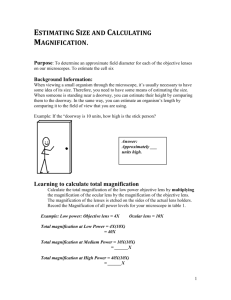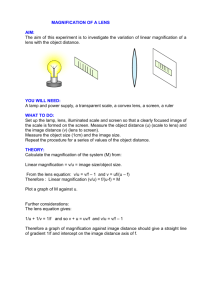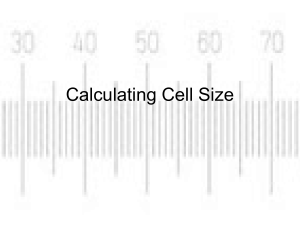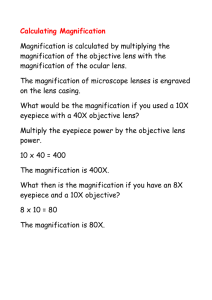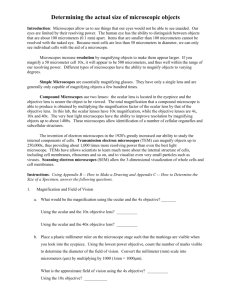Microscope Lab - Gloria-y
advertisement
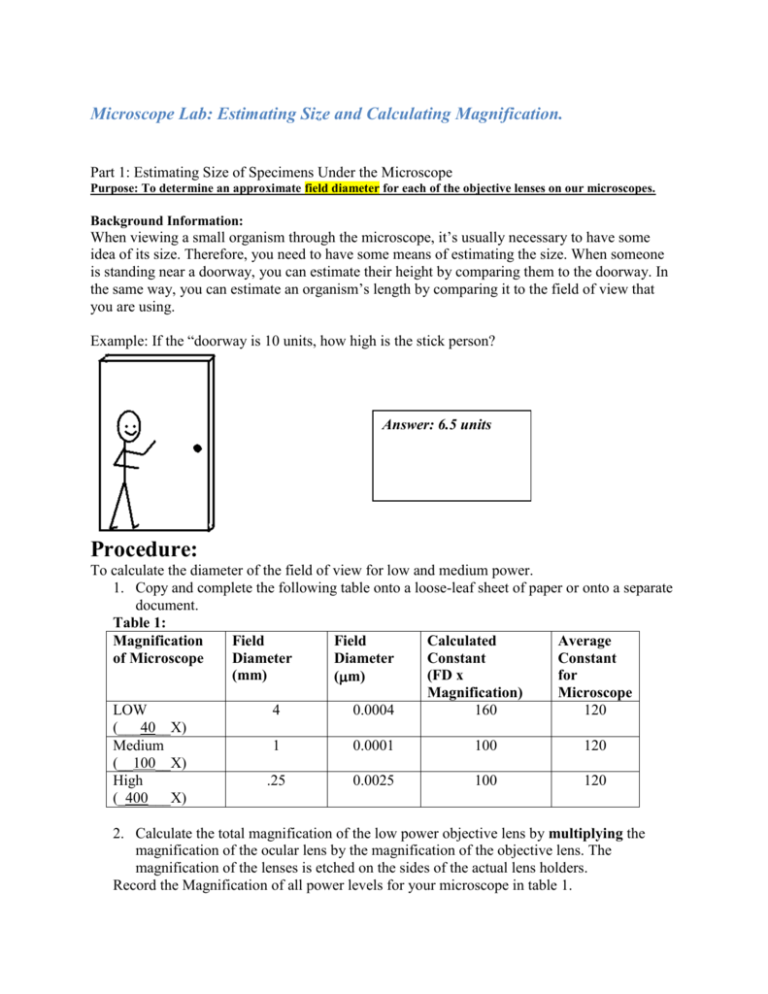
Microscope Lab: Estimating Size and Calculating Magnification. Part 1: Estimating Size of Specimens Under the Microscope Purpose: To determine an approximate field diameter for each of the objective lenses on our microscopes. Background Information: When viewing a small organism through the microscope, it’s usually necessary to have some idea of its size. Therefore, you need to have some means of estimating the size. When someone is standing near a doorway, you can estimate their height by comparing them to the doorway. In the same way, you can estimate an organism’s length by comparing it to the field of view that you are using. Example: If the “doorway is 10 units, how high is the stick person? Answer: 6.5 units Procedure: To calculate the diameter of the field of view for low and medium power. 1. Copy and complete the following table onto a loose-leaf sheet of paper or onto a separate document. Table 1: Magnification Field Field Calculated Average of Microscope Diameter Diameter Constant Constant (mm) (FD x for (m) Magnification) Microscope LOW 4 0.0004 160 120 (___40__X) Medium 1 0.0001 100 120 (__100__X) High .25 0.0025 100 120 (_400___X) 2. Calculate the total magnification of the low power objective lens by multiplying the magnification of the ocular lens by the magnification of the objective lens. The magnification of the lenses is etched on the sides of the actual lens holders. Record the Magnification of all power levels for your microscope in table 1. Example: Low power: Objective lens = 10X Ocular lens = 10X Total magnification at Low Power = 10X(10X) = 100X 3. Take a clear plastic ruler and examine the millimetre scale under low power. 4. Place the centre of one of the scale marks along the edge of the field as shown below. 5. Count the whole number of millimetre spaces. If there is part of a spacing, estimate (in decimals) the size of the millimetre portion that shows. Record the field diameter in millimetres in your data table 1. Example: The distance across this field of view is 4.2 mm. 6. Convert the field diameter for low power into micrometers and record this number in your data table 1. (1 m = 1/1000th mm) 7. Repeat steps #3-6 for the medium power objective lens. Do not use the ruler with high power. To calculate the field diameter for high power and the oil immersion lens. The field diameter for high power cannot be measure directly using your millimetre ruler because this field diameter is LESS than one millimetre. Therefore, we must calculate the field diameter a different way. All microscopes have a “constant” number that can be calculated: Field diameter x total magnification = a constant Once you know what the constant is for your microscope, you can use it to solve for the field diameter. Example: The constant for my microscope at home is 145. High power is 400X. What is the field diameter for my microscope at high power? Field diameter x total magnification = a constant Field diameter x 400X= 145 Field diameter = 145/400 Field diameter = 0.36 mm (Field diameter = 360 m) 1. In your data table, calculate the constant for both low and medium power. If you use the field diameter in millimetres for the first calculation, then you must use millimetres for the second calculation. It does not matter if you use millimetres or micrometers, just as long as you do the same for both calculations. The “constant” that you calculate will probably not be the same since we have been ESTIMATING the field diameter, and there is bound to be some error. 2. Take the average of the two constants calculated. Record this number in your data table. From now on, it is the AVERAGE constant that you will use for your calculations. (All four powers will have the same average constant) 3. Calculate the field diameter for the high power and the immersion lens using the formula: field diameter x total magnification = constant. Substitute the known values for the total magnification and the constant (the average) and then solve the equation for field diameter. 4. Complete the data table 1. 5. Compare your data table 1 with the rest of the class. Record your field diameters on a common chart at the front of the room. 6. Calculate the class average field diameter for each power and record this information in Data Table 2. We will use these values from now on when we are estimating the size of specimens under the microscopes. Discussion Questions: Use your information from your data table to answer the following questions. 1. Many ponds often have a green scum on the surface. This scum is a tangled mass of stringy algae filaments. Looking at a filament under high power shows four cells arranged end to end across the field of view. a. What is the diameter of your high power field of view in micrometers? 0.0025 b. How long is each cell approximately? 0.000625 micrometers 2. Given the following information, estimate the approximate actual size of the organisms in each case in micrometers. Round your answers to a convenient number. (they are only estimations). a. A bug stretches ½ way across the low power field. b. c. d. e. f. g. h. 0.0004/2= 0.0002 A cell stretches ¼ way across the medium power field 0.0001/4= 0.000025 Twenty cells fit across the high power field 0.0025/20=0.000125 Fifteen plant cells stretch across the medium power field 0.0001/15=0.00000667 A bug stretches 2/3 way across the medium power field (0.0001/3)*2=0.00006667 An insect stretches ¾ way across the high power field (0.0025/4)*3=0.001875 Five microbugs fit across the low power field. 0.0004/5=0.00008 Half a worm fits across the low power field. 0.0004/2=0.0002 Part 2: Calculating Magnification Much of the time you will be asked to draw what you see under the microscope. These drawings will be much larger than your specimen. You need to indicate, somehow, approximately how much larger than life your drawings (or photographs) are. The general formula for calculation magnification is: Magnification = drawing size Actual size M= D A You must ALWAYS use the same units for drawing size and actual size for this equation to work! Part 2 Discussion Questions: 1. To practice calculating magnification, copy the following chart into your lab report and in the table. (be careful with the units!) Actual Specimen Size Drawing Size Drawing Magnification 0.5 mm 2 cm 2/0.05= 40X cm 1 cm (10 000 um) 10 000/200= 50X um 200 m 2 cm 20 000/40=500X um 40 m 2 cm 200X 100 m 20 cm 12.5cm 5 cm 4 cm 100X 50X 2. A student, observing a micro-organism under a magnification of 40X, calculates that it is about 100m long. a. If she then draws the micro-organism 2 cm long, what is the magnification of her drawing? 20 000/100= 200X b. If her partner draws the micro-organism at a magnification of 1000X, how long will the drawing be? x/100= 1000 x= 10 3. You observe that an object stretches across ¾ of the low power field. What is its approximate length? What would be the magnification if you drew it 10cm long? (0.0004/4)*3=3mm 33X 4. If five cells fit across the high power field, what is their average length? If you draw one cell at the magnification of 500X, how long will your drawing be? 0.25/5= 0.05mm 500*0.05=25X 5. A paramecium swims across the medium power field in 15s. How fast is it swimming in micrometers per minute? 1mm/15s 4mm/1min Magnification Problem Set (Practice) Use your estimated field diameters for our microscopes to complete the following: a. A cell is observed to stretch half way across the high power field. How long is the cell? 0.125mm b. A Paramecium is observed to travel across the low power field in 5 seconds. Calculate its speed in m/s. 4mm/5s 0.0004um/5s c. 15 cells are observed across the centre of the high power field. How long is each cell? 0.25/15=0.017 d. A cell is observed under high power to be about half the field diameter. A student draws the cell 25cm in length. What is the magnification of the drawing? Cell=0.125mm 2500mm/0.125mm= 20,000X e. A student draws a cell diagram 24mm long. She writes 400X below the diagram. How large is the actual cell? f. g. h. i. 24/x=400X 400*24=x X=9600mm A cell is 80 m in length. If drawn 600 times actual size, how long will the drawing be in cm? 80*600=48 000um = 4.8cm 5 onion cells are counted across the centre of the high power field. One cell is drawn 18mm long. Calculate the drawing magnification. 18/0.05= 360X 40 potato cells are counted across the centre of the medium field of view. One cell is drawn 2cm long. What is the drawing magnification? 2/0.025=80X A fine hair is estimated to be in diameter, one tenth of the diameter of the high power field. It is drawn 4cm wide by a student. What is the drawing magnification? 0.25/10=0.025 4/0.025=160X j. Copy the chart and complete: Drawing Size Actual Size 10 000um 100m 12mm 4mm 10cm 250cm 15000um 15 um 800um 8m Drawing Magnification 100X 3X 25X 1000X 100X


